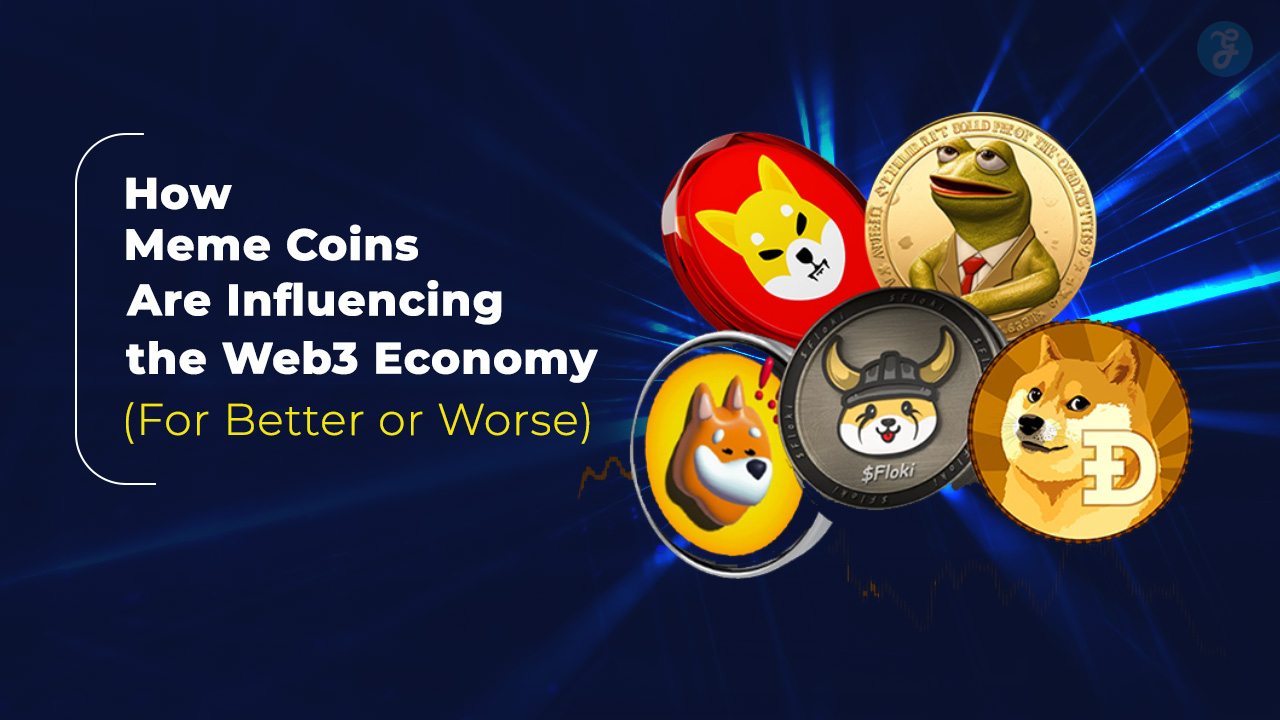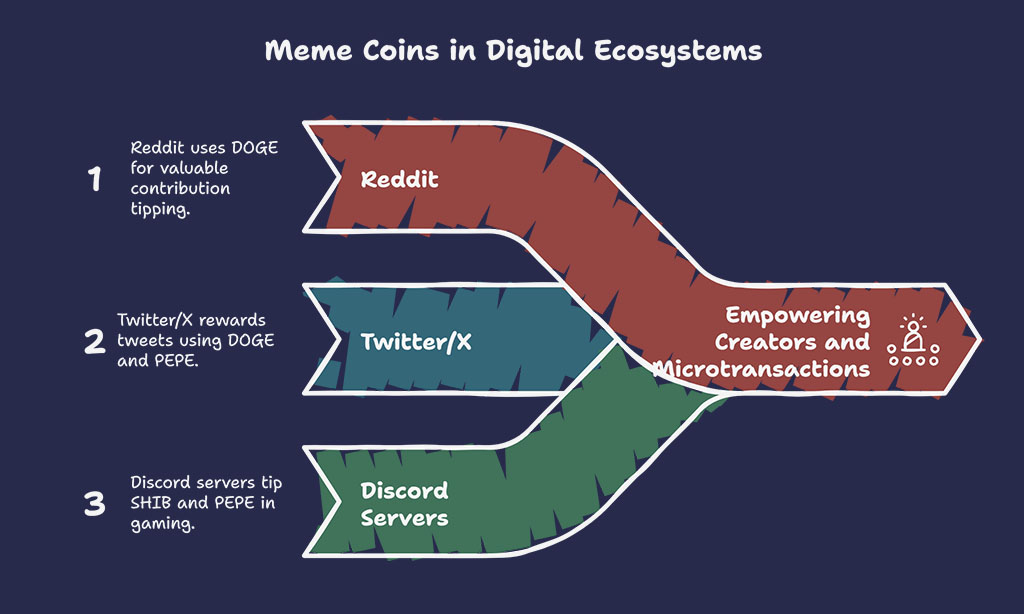In recent years, cryptocurrencies have taken the financial world by storm. While Bitcoin and Ethereum paved the way for digital currencies to gain legitimacy, another category of crypto has emerged—meme coins. Despite being initially dismissed as jokes, meme coins have proven they are more than fleeting internet trends.
In fact, how meme coins are influencing the Web3 economy is a phenomenon that’s capturing the attention of investors, developers, and decentralized communities alike.
The Web3 ecosystem, driven by decentralization, community ownership, and blockchain innovation, is undergoing rapid transformation. At the intersection of internet culture and decentralized finance, meme coins have carved out a powerful niche. Their humor, accessibility, and viral nature make them not only entertaining but surprisingly impactful in shaping the evolving digital economy.
This article explores how meme coins are influencing the Web3 economy—driving community engagement, tipping systems, onboarding new users, and even shaping decentralized governance models. Buckle up as we dive deep into the chaotic yet captivating world of meme coins in Web3.
What Are Meme Coins?
Meme coins are cryptocurrencies inspired by internet jokes, pop culture references, or online communities. Unlike traditional cryptocurrencies, which are typically built with clear use cases and long-term visions, meme coins often start as humorous experiments.
However, some, like Dogecoin and Shiba Inu, have defied expectations and reached multi-billion-dollar market caps.
These coins thrive on community-driven hype rather than underlying technical fundamentals. Despite their humorous origins, meme coins have sparked serious conversations about decentralized finance, social value, and the future of money in the Web3 landscape.
| Coin | Symbol | Origin Meme or Theme | Launch Year | Community Size |
| Dogecoin | DOGE | Doge [Shiba Inu Dog] | 2013 | 4M+ Reddit users |
| Shiba Inu | SHIB | “Doge Killer” | 2020 | 1.5M+ Holders |
| PEPE | PEPE | Pepe the Frog | 2023 | Growing rapidly |
| Floki Inu | FLOKI | Elon Musk’s Dog | 2021 | 300K+ Followers |
Why Meme Coins Gained Popularity
Several factors have fueled the rise of meme coins:
- Viral Marketing: Social media platforms like Reddit, Twitter, and TikTok have been instrumental in creating meme coin buzz. Viral tweets from celebrities and influencers amplify the reach exponentially.
- Community Involvement: Meme coins rely heavily on passionate online communities for growth and promotion. These communities become de facto marketing engines.
- Accessibility: Unlike expensive tokens like Bitcoin, meme coins are typically cheap, allowing new investors to buy large quantities and feel a sense of ownership.
- Speculation: Many investors are drawn to the “get-rich-quick” appeal of meme coins during bull markets. Success stories often fuel more speculation and hype.
| Factor | Description |
| Viral Marketing | High meme-ability leads to massive online exposure |
| Community Support | Users promote and build use-cases organically |
| Low Entry Cost | Users can own millions of coins without high investment |
| Speculative Gains | Quick profits attract short-term and long-term traders |
What is Web3?
Web3 represents the next generation of the internet—one that emphasizes decentralization, user ownership, and blockchain-based ecosystems. Unlike Web2, where power is concentrated in the hands of a few tech giants, Web3 gives control back to users through technologies like smart contracts, decentralized apps [dApps], and token-based governance systems. It redefines digital ownership and the flow of value across the internet.
Web3 is not a single product or platform but an evolving philosophy. It enables permissionless innovation, allowing anyone to build and monetize digital products without gatekeepers.
| Key Component | Role in Web3 |
| Blockchain | Underlying tech ensuring transparency and immutability |
| Smart Contracts | Code-driven agreements enabling trustless automation |
| dApps | Decentralized applications removing intermediaries |
| DAOs | Community-led governance mechanisms |
| Tokens | Assets used for value exchange, incentives, or access |
Web3 vs. Traditional Internet Models
Here’s a quick comparison to understand the shift:
| Feature | Web2 | Web3 |
| Ownership | Centralized corporations | Decentralized users |
| Data Control | Platform-owned | User-controlled |
| Monetization | Ad-based | Token-based |
| Governance | Corporate executives | Community via DAOs |
| Infrastructure | Centralized servers | Blockchain networks |
How Meme Coins Are Influencing the Web3 Economy
Meme coins have gradually shifted from being a fringe part of crypto culture to playing influential roles in the decentralized economy. Their playful origins mask a surprisingly powerful force that’s reshaping how online communities engage, govern, and participate in blockchain ecosystems.
Web3, being inherently open-source and participatory, provides the perfect environment for meme coins to thrive. These coins have not only brought new energy to blockchain projects but also encouraged broader public interaction with decentralized platforms.
More importantly, the viral nature of meme coins acts as a gateway to larger Web3 use cases. By drawing in users with humor and accessibility, they gradually expose them to more complex elements like DAOs, DeFi, NFTs, and metaverse assets.
This makes them an effective onboarding tool and a cultural bridge between mainstream audiences and emerging digital infrastructure.
1. Driving Community Engagement and DAOs
Meme coins are masters of community engagement. Unlike traditional financial tools, they are built with humor, inclusivity, and creativity at their core. Communities rally around these coins not because of utility, but because of shared culture and values. This collective participation turns passive users into active builders.
DAOs [Decentralized Autonomous Organizations] have become a vital aspect of this engagement. Meme coins have begun integrating DAO features to enable transparent decision-making.
Case Study: Shiba Inu’s DAO-like feature, Doggy DAO, allows users to vote on future ecosystem developments including liquidity pools and token pairings.
| Project | DAO Feature | Community Voting Example |
| Shiba Inu | Doggy DAO | SHIB holders vote on liquidity and listings |
| Floki Inu | FlokiFi DAO | Users influence product development roadmap |
| Cult DAO | Meme token built as DAO | Community directs funding of crypto projects |
2. Fueling Microtransactions and Tip Economies
Meme coins are gaining traction for tipping and microtransactions, especially across social platforms and within digital creator ecosystems. Thanks to their low individual value, they are practical for sending small payments with minimal fees, making them ideal for everyday peer-to-peer exchanges.
This behavior supports the broader Web3 ethos of empowering creators and bypassing traditional monetization platforms like YouTube or Patreon.
Example: Dogecoin was used as a tipping tool during the 2021 Tokyo Olympics on Twitter, and Reddit communities regularly use it to reward valuable content.
| Platform | Meme Coin Used | Use Case |
| DOGE | Tipping users for valuable contributions | |
| Twitter/X | DOGE, PEPE | Rewarding tweets, promoting content |
| Discord Servers | SHIB, PEPE | Used in gaming and NFT community tips |
3. Lowering Entry Barriers in Crypto Adoption
One of the main reasons how meme coins are influencing the Web3 economy is by making crypto more approachable and less intimidating for beginners. These tokens offer a simplified entry point for those who might find blockchain technology or decentralized finance overwhelming.
With relatable branding, humorous origins, and often a low cost of entry, meme coins attract users who are new to the crypto space. They spark curiosity and act as a cultural bridge, encouraging users to explore deeper layers of the Web3 ecosystem over time. In many ways, meme coins serve as the first step in a much larger journey toward understanding digital assets and decentralized platforms.
They serve as a cultural and technical gateway into blockchain, sparking curiosity in more advanced use-cases like staking, liquidity pools, and NFTs.
| Benefit | Explanation |
| Low Price Entry | Reduces intimidation for first-time investors |
| Pop Culture Appeal | Meme themes drive emotional and cultural connection |
| Community Education | Communities help onboard and educate newcomers via tutorials, memes |
4. Promoting Decentralized Culture and Humor
Meme coins aren’t just financial assets—they’re cultural artifacts embedded with collective digital identity, humor, and ideology. Their existence challenges traditional finance by adding a layer of absurdity and humor to serious economic discussions.
By disrupting conventional narratives about what money should be or look like, meme coins carve a space for more relatable and inclusive participation in financial systems. They celebrate the decentralized spirit of the internet while offering a playful yet provocative way to engage with complex ideas around value, community, and technology.
They promote a decentralized ethos while reinforcing the idea that finance doesn’t have to be boring. Humor becomes a powerful tool for mass adoption.
Notable Moment: In 2021, Dogecoin donations helped sponsor Jamaica’s bobsled team for the Winter Olympics, drawing massive media coverage and increasing crypto visibility.
| Aspect | Role in Web3 Culture |
| Memes | Spread concepts virally and make tech accessible |
| Community Humor | Builds emotional loyalty and participation |
| Campaigns & Charity | Promote decentralized goodwill and community outreach |
Engagement Element: Poll or Comment Prompt
Do you think meme coins will shape the future of Web3 or fade out? Let us know in the comments or vote in our community poll!
Potential Risks and Limitations
Despite their growing presence in the Web3 space, meme coins are not without concerns. Their unpredictable nature, lack of utility, and often unvetted development teams introduce significant risks to investors and the broader ecosystem.
Understanding these limitations is crucial for anyone engaging with meme coins as part of a Web3 strategy.
Volatility and Speculative Bubbles
Despite their charm, meme coins are notoriously volatile. Prices can surge based on a tweet and crash just as quickly. This has led to concerns about:
- Pump-and-dump schemes where insiders dump tokens on retail buyers
- Rug pulls from fraudulent or unserious developers
- Extreme price swings based on meme cycles or influencer posts
| Risk Factor | Description |
| Price Volatility | Meme coins often move >50% within days |
| Lack of Regulation | Few safeguards for investors |
| Information Asymmetry | Developers may control large shares of tokens |
Lack of Utility and Long-Term Vision
While some meme coins have started developing ecosystems [e.g., Shiba Inu’s ShibaSwap], most lack real-world utility. This makes them vulnerable to:
- Losing user interest over time
- Becoming outdated memes
- Regulation targeting non-utility tokens
| Weakness | Impact on Web3 Adoption |
| No Defined Roadmap | Limited investor confidence |
| Meme Fatigue | Loss of relevance as trends change |
| Copycat Projects | Market clutter reduces credibility |
Future Outlook: Can Meme Coins Sustain in Web3?
The future of meme coins in the Web3 ecosystem remains both exciting and uncertain. As more users explore decentralized technologies, meme coins face the challenge of evolving beyond their novelty origins.
For them to endure and grow, they must embrace innovation, develop sustainable ecosystems, and offer tangible value to users. While the meme-driven hype may spark initial interest, long-term success will depend on whether these coins can deliver real utility and continue fostering active, engaged communities in the Web3 space.
Innovation Opportunities
To remain relevant in the Web3 space, meme coins must innovate. The future may see hybrid use-cases that blend meme appeal with DeFi, gaming, and real-world applications.
Emerging trends include:
- Meme-based staking for yield generation
- NFT integration with meme coin avatars and collectibles
- Play-to-earn games using meme coins as in-game currencies
| Innovation Path | Description |
| MemeFi [DeFi + Memes] | Staking and farming rewards with meme coin branding |
| NFT Ecosystems | Using meme coins to buy, trade or mint NFTs |
| Gamified Utility | Integration in mobile or Web3 games |
Expert Predictions
Crypto analysts and influencers have mixed opinions:
- “Meme coins are onboarding tools—good for mass adoption but risky.” – CryptoBanter
- “Community tokens may evolve into real economic tools.” – Vitalik Buterin
- “95% of meme coins will fade, but a few will reinvent the game.” – CoinDesk contributor
| Expert | Viewpoint |
| CryptoBanter | Meme coins as educational tools with short-term cycles |
| Vitalik B. | Believes in community-led economic experimentation |
| CoinDesk | Highlights saturation but acknowledges innovation potential |
Takeaways
The story of how meme coins are influencing the Web3 economy is still unfolding. These tokens, born out of humor and digital culture, have matured into symbols of community-driven financial experimentation.
From driving community-driven governance to enabling micro-transactions and onboarding new users, meme coins are more than internet jokes—they’re catalysts for change in a decentralized future. Their value lies not only in market speculation but in their ability to foster new forms of engagement, creativity, and inclusive participation in digital economies.
While they come with volatility and risk, their impact on Web3 culture, user growth, and experimentation is undeniable. Whether you’re a crypto veteran or a curious newcomer, meme coins offer a glimpse into the playful, rebellious, and radically inclusive spirit of the Web3 economy.
As we continue to watch how meme coins are influencing the Web3 economy, one thing is clear: this movement is far from over—and it might just reshape the digital world as we know it.




































